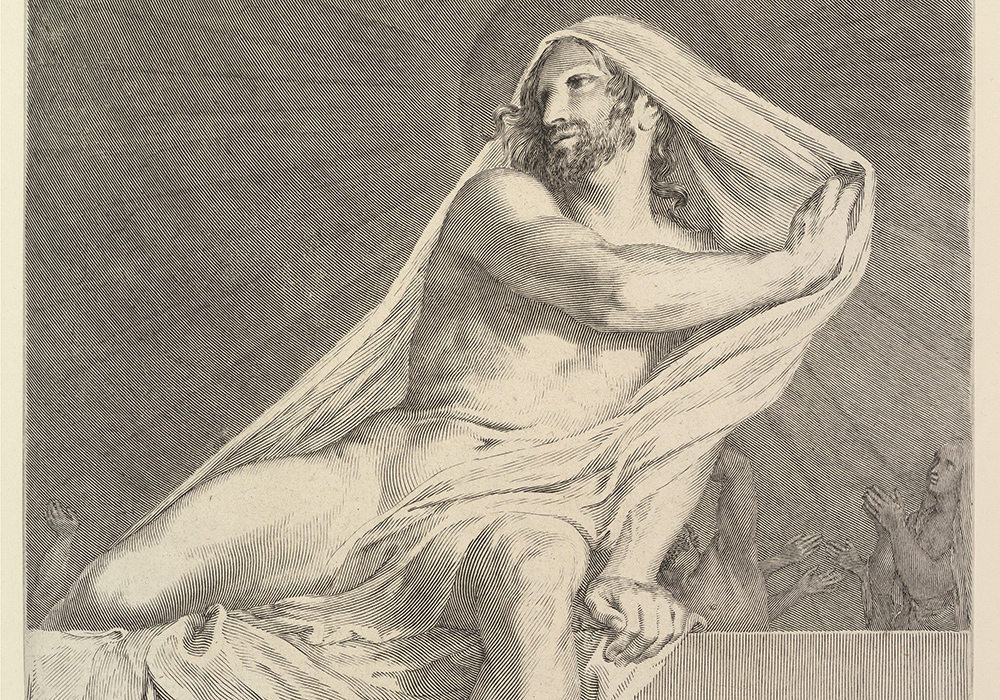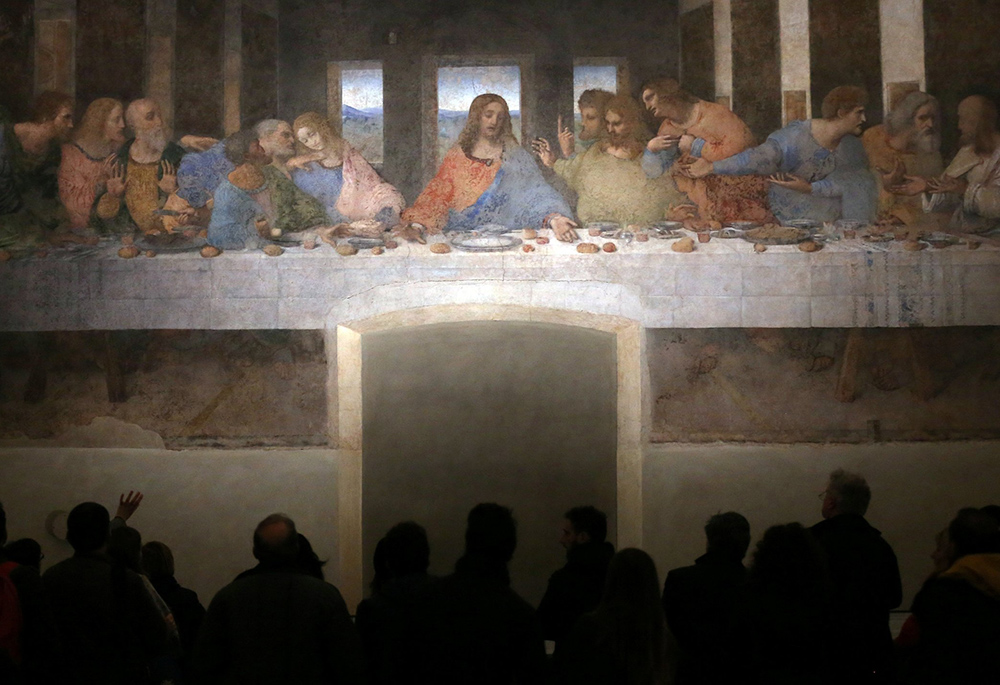Mary DeTurris Poust is a writer and retreat leader living in New York’s Capital Region. Visit her website at www.NotStrictlySpiritual.com.
<div style="text-align: center;"><div style="margin-bottom: 10px; padding-bottom: 10px; border-bottom: 1px dotted #ccc;" class="full_width_image"><img style="width: 624px; max-width: 100%;" src="https://www.ncronline.org/files/styles/email_newsletter_full_width/publ… style="color: #04619d; text-decoration: none;" href="
Secondary 550 Ad

"The Resurrection," a 1683 engraving by Claude Mellan (Metropolitan Museum of Art)
March 31 — the end of another calendar month — ushers in a season of profound hope as Christians everywhere celebrate Easter, the commemoration of Christ's resurrection. Many times Easter and the Jewish feast of Passover overlap, but not this year. Easter symbolizes new life and often coincides with the spring season in the Northern Hemisphere. Springtime, a season of rejuvenation and rebirth, reminds us that before new life can emerge, the old must first pass away.
Ecologically, the natural world is forever trying to renew itself. The brilliantly colored tree leaves of autumn turn brown, die and fall to the ground, leaving tree limbs bare until new buds burst forth and flower, greening Earth's landscape once again. Also in the natural world eight living beings shed their skin in the growth and rebirth process: snakes, true crabs, frogs, dragonflies, geckos, spiders, cicadas and humans. Once a snake is free of its old skin, the snake's colors become bright and vibrant. Some young spiders shed their skins so that their limbs can regenerate. The natural process that non-human life goes through is called ecdysis.
Today's Easter readings highlight three things that need to happen in the lives of Christians if Christians want to participate ever more deeply in the new life of the risen Christ whose divine spirit and power infuses the entire cosmos.
First, if we Christians wish to become an "Easter people," then we have to clear out the old yeast in our lives. 1 Corinthians 5 focuses on yeast and dough. In this letter, the festival of Unleavened Bread celebrated at the time of Passover is linked to Easter and the resurrection of Christ. As part of the Festival of Unleavened Bread, the Jewish people had to remove all old leaven from their homes. Leavened bread contains yeast, a living, single-cell organism that, when mixed with dough, causes the dough to rise. Old or "expired" yeast, however, could cause illnesses and even keep the dough from rising. Thus, during the Festival of Unleavened Bread and Passover, the Jewish people were to eat only untainted, unleavened bread.
The reading from 1 Corinthians calls us to get rid of the old, expired yeast in the fabric of our lives so we can become a new fresh batch of dough that, when baked, turns into unleavened bread. Thus, by clearing out the "old yeast" within us and by becoming a new batch of dough, we prepare ourselves to be changed into unleavened bread and essentially, to be transformed into Christ. The question to be explored is this: what in our lives is old and expired yeast that needs to be cleared out?
Second, if Christians wish to participate in Christ's rising from the dead, then we have to shed, figuratively, our burial clothes. The Gospel reading from John tells the story of Mary of Magdala, Simon Peter, and a beloved disciple discovering that the body of the crucified, dead Jesus was no longer in the tomb where he was laid to rest. Instead, all they found there were Jesus' burial clothes.
Advertisement
According to the Gospel story, as part of Christ's rising from the dead, he shed his old burial clothes like the snake that shed its skin, both becoming bright and vibrant. Even though we are among the living, are we wearing burial clothes? What in our lives represents burial clothes? Have we dressed ourselves in these clothes or allowed others to dress us in them? Are we willing to shed these clothes to rise from the dead and become one with the living, wonder-full Christ or are we content to be part of the living dead spiritually, emotionally, psychologically, socially, intellectually? Easter invites us to put on vibrant new garments — essentially, to "put on Christ."
Third, if Christians wish to be an "Easter people," sharing in the gift of new life while bearing witness to the resurrection of Christ, then just singing "alleluia" is not enough. Today's reading from the Acts of the Apostles reminds us that the Divine One anointed Jesus of Nazareth with the Spirit and with power which, in turn, empowered Christ to embrace and live out his holy mission of preaching, teaching, healing and liberating all who were oppressed.
We, too, who walk in the tradition of the apostles, are baptized into Christ. We have been anointed with the Spirit, and we have the same mission as Christ and the apostles. To be an Easter people means to do the work of Easter: to confront and work against hegemonic, systemic and structural injustices while creating alternatives, to shake up the status quo, to welcome the marginalized, to embrace all creation with a healing love. And if we find ourselves like the stone that the builders rejected, then we can rest assured that the risen Christ is alive and well among us and within us.
<div style="text-align: center;"><div style="max-width: 400px; margin: 0 auto;"><a href="https://www.ncronline.org/vatican/francis-comic-strip/francis-comic-str… style="max-width: 100%;" src="https://www.ncronline.org/files/styles/

Visitors are pictured in a file photo looking at Leonardo da Vinci's "The Last Supper" on a refectory wall at Santa Maria delle Grazie Church in Milan. (OSV News/Reuters/Stefano Rellandini)
Liturgy is drama, and Holy Week invites us not just to watch but to play our own part.
The rituals of remembrance last an entire week (and a lifetime), drawing us evermore deeply into the mystery of God's love. We begin with the carefully choreographed entry into Jerusalem, then the plots, an anointing, the preparation and celebration of the supper and finally, the Passion that begins in the garden of arrest and is fulfilled in the garden of the empty tomb. This week is one prolonged invitation to communion with and in Christ. Because it's too much to take we can choose any event and discover that it summarizes them all. In this year of synodality and the U.S. eucharistic revival, Jesus' last meal with his disciples seems a fitting choice.
The conversation initiating this story has easily overlooked subtleties. Amid feasting and danger, the disciples ask Jesus, "Where do you want us to prepare for you to eat the Passover?" In reply, Jesus gives them a task that demonstrates that he has already prepared for all that is to come. Following Jesus' instructions, they find the householder who will provide a place for Jesus to eat "with my disciples." In Jesus' eyes, this meal will implicate every participant.
What Jesus does at the table summarizes his entire life and mission. As the host, Jesus blesses the bread as usual. Yet this time he radically refocuses the blessing.
The traditional blessings for bread and wine gave thanks for God's constant care. Holding the bread, the host would say: "Blessed art thou, O Lord our God, King of the universe, who brings forth bread from the earth." In the name of all present, the host then takes the wine saying, "Blessed art thou . . . who creates the fruit of the vine." We see that Jesus did not bless the food and drink, he blessed God for sustaining all life. Rather than sanctifying the elements, this blessing recognized the innate holiness of everything that comes from God. Such a blessing forms the participants into a community united in praise and thanksgiving, and in awareness that all we are and have comes from God who unites Self with us as intimately as the food that sustains us.
Mark, Matthew and Luke each record how Jesus' blessings of the bread and wine at this supper diverged from tradition. In Jesus' culture, the body represented the whole person in relationship with others. Blood was the sacred life force of the body.
When Jesus blessed and broke the bread, he added the audacious statement, "This is my body." By saying that, Jesus identified himself, not as a grateful recipient of God's gifts, but as the gift of God. Taking the wine, Jesus pronounced the traditional blessing and went on to identify himself as the lifeblood of the covenant, God's vulnerable offer to share life with creation — no matter the supposed worthiness or unworthiness of the people.
Advertisement
Now, Mark reiterates what he depicted when the disciples offered to prepare the Passover for Jesus and his reply that they were all to be full participants in it. Jesus blessed, broke and gave them the bread, offering them his very self as the gift of life. Then, when Jesus took the cup, blessed and gave it to them, they all drank of it. Only after they had accepted it, did Jesus explain that it was communion in his life of being poured out for the many. By eating and drinking this bread and wine with him, they took in the gift of God that he was and entered into his own self-giving (Mark 10:28-30). This was their Passover, their full communion with and in him. This suggests that the command, "Do this in memory of me," refers to Jesus' self-giving and that our ritual is meant to draw us into communion with and in him so that we too will become God's gift of life for the many.
What are we to take from this?
Today, we watched the spectators shout, "Hosanna," and soon thereafter cry out, "Crucify him!" The Scriptures and liturgies of Holy Week make it hard to be neutral. They interrogate us, calling us to play our part in the drama of God's great love. We are free to remain spectators, swaying with the wind. We might be trapped among those whose clinging to their plan or power blinds them to God's offer. Or we may choose the strength and freedom offered in the bread that gives us the sustenance necessary to take up the cup of self-giving love.
This week of remembrance leads us to ask ourselves, "Are we prepared to be implicated with Christ?" Do we believe it when we say, "Lord, by your cross and resurrection you have set us free"?
<div style="text-align: center;"><div style="margin-bottom: 10px; padding-bottom: 10px; border-bottom: 1px dotted #ccc;" class="full_width_image"><img style="width: 624px; max-width: 100%;" src="https://www.ncronline.org/files/styles/email_newsletter_full_width/publ… style="color: #04619d; text-decoration: none;" href="
<h2><a style="color: #04619d; text-decoration: none;" href="https://www.ncronline.org/opinion/guest-voices/catholic-church-needs-ma… Catholic Church needs married priests now</a></h2><div style="font-weight: bold; font-size: 15px; font-family: Arial, sans-serif;" class="byline">by Thomas Reese</div><div style="font-size: 19px; font-family: 'Georgia', serif;"><p>In many parts of
<h2><a style="color: #04619d; text-decoration: none;" href="https://www.ncronline.org/opinion/ncr-voices/case-returning-movie-theat… case for returning to movie theaters in the age of streaming</a></h2><div style="font-weight: bold; font-size: 15px; font-family: Arial, sans-serif;" class="byline">by Daniel P.

